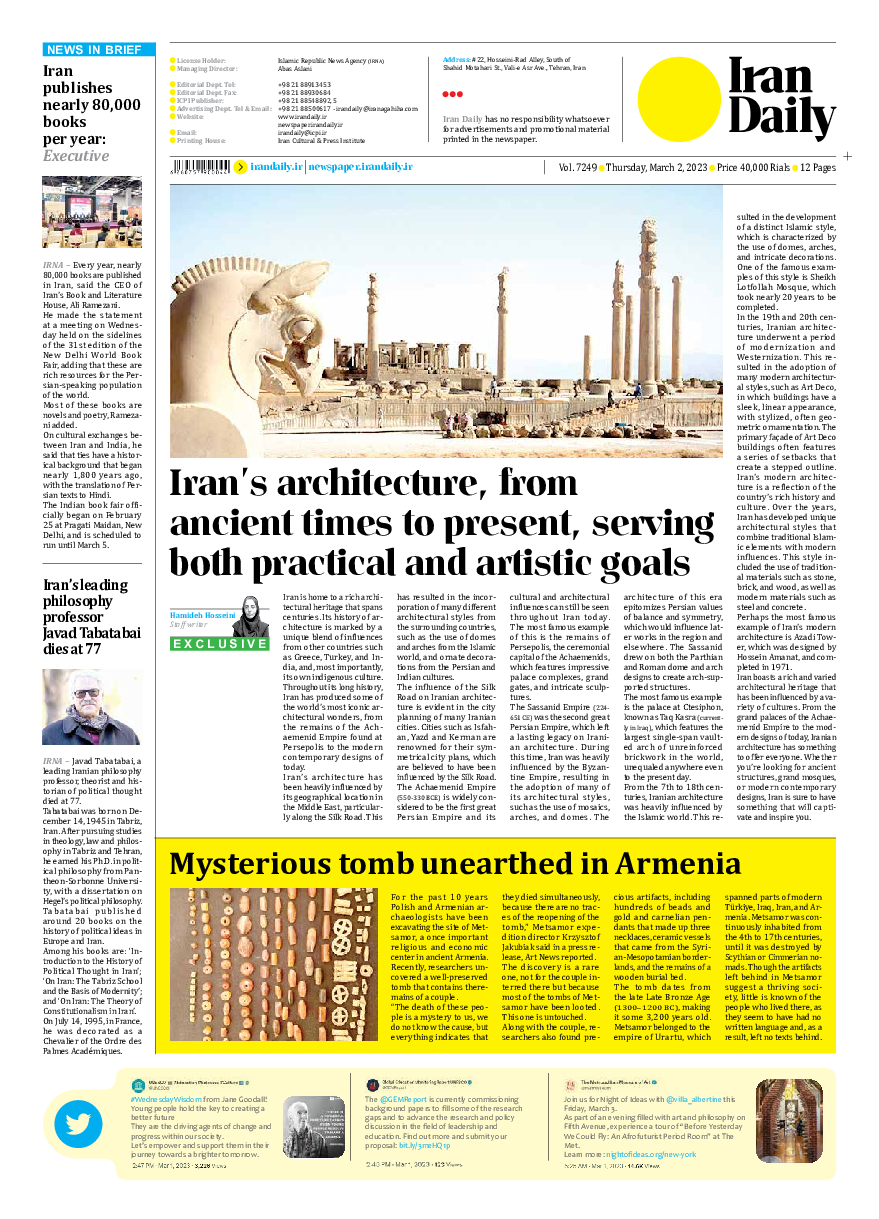
EXCLUSIVE
Iran’s architecture, from ancient times to present, serving both practical and artistic goals
Hamideh Hosseini
Staff writer
Iran is home to a rich architectural heritage that spans centuries. Its history of architecture is marked by a unique blend of influences from other countries such as Greece, Turkey, and India, and, most importantly, its own indigenous culture. Throughout its long history, Iran has produced some of the world’s most iconic architectural wonders, from the remains of the Achaemenid Empire found at Persepolis to the modern contemporary designs of today.
Iran’s architecture has been heavily influenced by its geographical location in the Middle East, particularly along the Silk Road. This has resulted in the incorporation of many different architectural styles from the surrounding countries, such as the use of domes and arches from the Islamic world, and ornate decorations from the Persian and Indian cultures.
The influence of the Silk Road on Iranian architecture is evident in the city planning of many Iranian cities. Cities such as Isfahan, Yazd and Kerman are renowned for their symmetrical city plans, which are believed to have been influenced by the Silk Road.
The Achaemenid Empire (550-330 BCE) is widely considered to be the first great Persian Empire and its cultural and architectural influences can still be seen throughout Iran today. The most famous example of this is the remains of Persepolis, the ceremonial capital of the Achaemenids, which features impressive palace complexes, grand gates, and intricate sculptures.
The Sassanid Empire (224-651 CE) was the second great Persian Empire, which left a lasting legacy on Iranian architecture. During this time, Iran was heavily influenced by the Byzantine Empire, resulting in the adoption of many of its architectural styles, such as the use of mosaics, arches, and domes. The architecture of this era epitomizes Persian values of balance and symmetry, which would influence later works in the region and elsewhere. The Sassanid drew on both the Parthian and Roman dome and arch designs to create arch-supported structures.
The most famous example is the palace at Ctesiphon, known as Taq Kasra (currently in Iraq), which features the largest single-span vaulted arch of unreinforced brickwork in the world, unequaled anywhere even to the present day.
From the 7th to 18th centuries, Iranian architecture was heavily influenced by the Islamic world. This resulted in the development of a distinct Islamic style, which is characterized by the use of domes, arches, and intricate decorations. One of the famous examples of this style is Sheikh Lotfollah Mosque, which took nearly 20 years to be completed.
In the 19th and 20th centuries, Iranian architecture underwent a period of modernization and Westernization. This resulted in the adoption of many modern architectural styles, such as Art Deco, in which buildings have a sleek, linear appearance, with stylized, often geometric ornamentation. The primary façade of Art Deco buildings often features a series of setbacks that create a stepped outline. Iran’s modern architecture is a reflection of the country’s rich history and culture. Over the years, Iran has developed unique architectural styles that combine traditional Islamic elements with modern influences. This style included the use of traditional materials such as stone, brick, and wood, as well as modern materials such as steel and concrete.
Perhaps the most famous example of Iran’s modern architecture is Azadi Tower, which was designed by Hossein Amanat, and completed in 1971.
Iran boasts a rich and varied architectural heritage that has been influenced by a variety of cultures. From the grand palaces of the Achaemenid Empire to the modern designs of today, Iranian architecture has something to offer everyone. Whether you’re looking for ancient structures, grand mosques, or modern contemporary designs, Iran is sure to have something that will captivate and inspire you.







